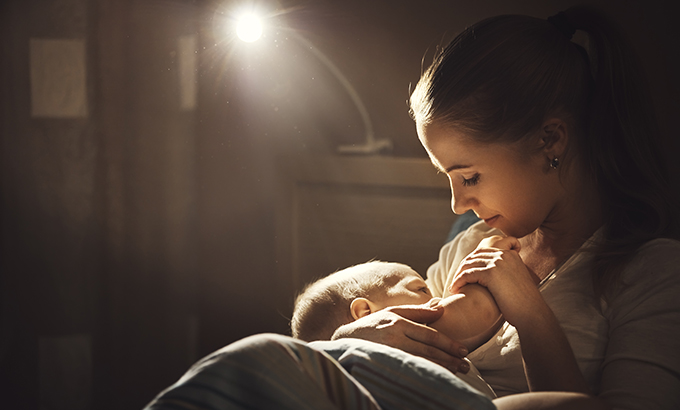Newborns have difficulty distinguishing between day and night, which explains their short bursts. However, when your baby is a few weeks old, he can start to teach himself the difference and you can gain a healthy sleeping habit when you’re with him. Expert tips can help you do this:
“The lights biologically push the ‘move‘ button on your child,” experts say. The dark secretes melatonin in the brain, which is an important sleep hormone. Keep your baby’s days bright and nights dark so he quickly understands when it’s time to sleep.

• During the day, make sure the house gets plenty of light or take it outside. Place your baby in a well-lit room during daytime naps.
• To avoid waking up at night, consider installing a brightness adjuster over the lights in your baby’s room; also consider installing brightness adjusters in other rooms where you spend a lot of time. Reduce the brightness of the lights in the evening or 2 hours before bedtime to set the mood.
• It’s nice to use a night light in your room, but choose a dim light and don’t install it near beds or curtains.
• If your child wakes up during the night, do not turn on the lights or move them to a bright room. The transition from darkness to light signals your brain that it’s time to wake up. Instead, soothe her in the dark bedroom.
• If sunlight wakes your child too early or they have trouble sleeping in the afternoon, you may want to consider darkening the tones of the room.
Put your baby to bed when he is sleepy.
This is a long-term step, especially for breastfeeding mothers, but you can adjust the timing with it so that both you and your baby are relieved. Babies who spontaneously sleep tend to learn to comfort themselves, experts say.

Wait a little before you go to your baby.
If you jump at every noise heard from your baby’s audio device, you’re teaching your child to wake up more often. Wait a few minutes to give him time to sleep alone. If she doesn’t, and it looks like she’s awake, you might even be right to wait for her to start crying. However, going to her before a major crying attack means putting her to sleep without losing much time.
Either way, adjusting the sensitivity on your baby’s sound device is a sensible option so you don’t hesitate every time your baby makes a sound.
Try not to look your baby in the eye.
Many babies are easily stimulated. Just greeting your baby’s gaze can catch his attention and show his playtime.
Parents who make eye contact with sleepy babies cause their babies to go out of sleep mode. The more interaction between you and your baby during the night, the more motivation they will have to get up.
So what should I do instead?
When you go to your baby at night, don’t make eye contact, talk excitedly, or sing her favorite song. Keep your gaze on her belly and soothe her as she sleeps with a calm voice and a soft touch.

Relax the rules for diaper changes.
Resist the urge to change your baby’s diaper every time she wakes up. Wear night diapers before going to bed at night. When he wakes up, check his diaper by sniffing it, and if he poops, change his diaper. Warming up wet wipes at night when you’re changing diapers can be a sensible choice.
Give your baby a “dream meal.”
If your baby is having trouble sleeping, waking him up in the middle of the night to feed may help you sleep longer.
Keep the lights dim and gently lift your sleeping baby from their diaper. Take them into your lap to breastfeed. After you’re done, put them back to bed without settling them down.
Don’t worry about sleep habit decline.
If your baby starts to wake up again at night, don’t panic. It’s probably a temporary action. Milestones for infants and toddlers can often vary in situations such as travel, illness, and new siblings. Many parents think that babies become more active with sleep problems and their sleep patterns start from 4 months.
